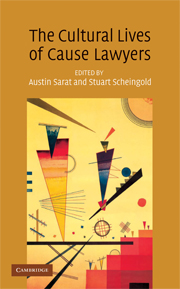Book contents
- Frontmatter
- Contents
- Acknowledgments
- Contributors
- Bringing Cultural Analysis to the Study of Cause Lawyers: An Introduction
- PART I THE CULTURAL WORK OF CAUSE LAWYERS
- PART II THE CULTURAL CONSTRUCTION OF LAWYERS AND THEIR CAUSES
- 4 “They all have different policies, so of course they have to give different news”: Images of Human Rights Lawyers in the British Press
- 5 Ed Fagan and the Ethics of Causes: Who Stole Identity Politics?
- 6 Of Windmills and Wetlands: The Press and the Romance of Property Rights
- 7 “The Kids are Alright”: Cause Lawyering on Television in 1960s America
- 8 Nothing to Believe In – Lawyers in Contemporary Films About Public Interest Litigation
- 9 “Of course he just stood there; he's the law”: Two Depictions of Cause Lawyers in Post-Authoritarian Chile
- 10 Paulina Escobar as Cause Lawyer: “Litigating” Human Rights in the Shadows of Death and the Maiden
- PART III THE CULTURAL RECEPTION OF LAWYERS AND THEIR CAUSES
- Index
5 - Ed Fagan and the Ethics of Causes: Who Stole Identity Politics?
Published online by Cambridge University Press: 08 January 2010
- Frontmatter
- Contents
- Acknowledgments
- Contributors
- Bringing Cultural Analysis to the Study of Cause Lawyers: An Introduction
- PART I THE CULTURAL WORK OF CAUSE LAWYERS
- PART II THE CULTURAL CONSTRUCTION OF LAWYERS AND THEIR CAUSES
- 4 “They all have different policies, so of course they have to give different news”: Images of Human Rights Lawyers in the British Press
- 5 Ed Fagan and the Ethics of Causes: Who Stole Identity Politics?
- 6 Of Windmills and Wetlands: The Press and the Romance of Property Rights
- 7 “The Kids are Alright”: Cause Lawyering on Television in 1960s America
- 8 Nothing to Believe In – Lawyers in Contemporary Films About Public Interest Litigation
- 9 “Of course he just stood there; he's the law”: Two Depictions of Cause Lawyers in Post-Authoritarian Chile
- 10 Paulina Escobar as Cause Lawyer: “Litigating” Human Rights in the Shadows of Death and the Maiden
- PART III THE CULTURAL RECEPTION OF LAWYERS AND THEIR CAUSES
- Index
Summary
How can we understand the cultural life of any group? Where in culture do we find such life? The answer lies partly in the query, What is actively “living” in the nominal repository of “life,” and how do representations of that living cohere with or distend from the “lived”? For as culture is that realm that is always in circulation, moving and shifting amidst people even as it is created and remade through repetitive channels, locating in and across groups a cultural life is an arguably formidable task. Nevertheless, media representations certainly influence the transmission of cultural ideas. The media, as a series of vessels, assist in perpetuating the ways in which representative notions and images “live” as they are distributed daily. To some degree the cultural life of any group must exist in an eternally suspicious mimetic relation to its members. As each member's unique lived performance may or may not correspond with media representations of the group's lived condition, the cultural life of a group must necessarily be a partial figment of imagination and a rhetorical strategy. Because of its link to representation, the cultural life of any group can only be that which becomes a normative measurement device against which active lived performance is ascertained and judged. There may, however, be utter incommensurability between the cultural life of images taken as reflective of the “real” and the lived events of bodies.
- Type
- Chapter
- Information
- The Cultural Lives of Cause Lawyers , pp. 172 - 187Publisher: Cambridge University PressPrint publication year: 2008

